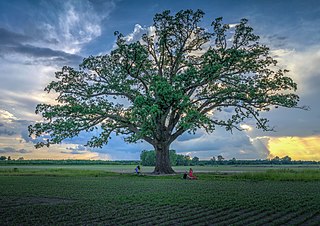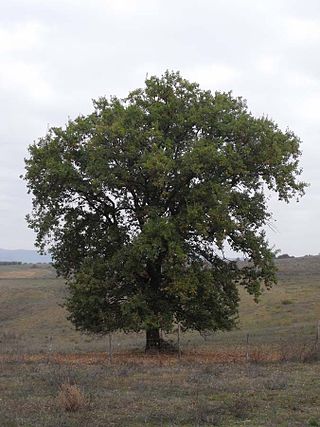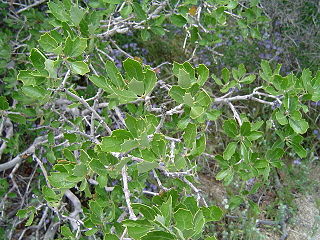
Quercus alba, the white oak, is one of the preeminent hardwoods of eastern and central North America. It is a long-lived oak, native to eastern and central North America and found from Minnesota, Ontario, Quebec, and southern Maine south as far as northern Florida and eastern Texas. Specimens have been documented to be over 450 years old.

Quercus ilex, the evergreen oak, holly oak or holm oak is a large evergreen oak native to the Mediterranean region. It is a member of the Ilex section of the genus, with acorns that mature in a single summer.

Quercus suber, commonly called the cork oak, is a medium-sized, evergreen oak tree in the section Quercus sect. Cerris. It is the primary source of cork for wine bottle stoppers and other uses, such as cork flooring and as the cores of cricket balls. It is native to southwest Europe and northwest Africa. In the Mediterranean basin the tree is an ancient species with fossil remnants dating back to the Tertiary period.

Quercus petraea, commonly known as the sessile oak, Cornish oak, Irish Oak or durmast oak, is a species of oak tree native to most of Europe and into Anatolia and Iran. The sessile oak is the national tree of Ireland, and an unofficial emblem in Wales and Cornwall.

Quercus macrocarpa, the bur oak or burr oak, is a species of oak tree native to eastern North America. It is in the white oak section, Quercus sect. Quercus, and is also called mossycup oak, mossycup white oak, blue oak, or scrub oak. The acorns are the largest of any North American oak, and are important food for wildlife.

Quercus pubescens, commonly known as the downy oak, pubescent oak or Italian oak, is a species of white oak native to southern Europe and southwest Asia. It is found from northern Spain (Pyrenees) and France in the West to Turkey and the Caucasus in the East.

Quercus berberidifolia, the California scrub oak, is a small evergreen or semi-evergreen shrubby oak in the white oak section of Quercus. It is a native of the scrubby hills of California, and is a common member of chaparral ecosystems.

Quercus pontica, the Pontine oak or Armenian oak, is a species of endangered oak currently extant to the western Caucasus mountains of Georgia and northeastern Turkey where it grows at altitudes of 1,300–2,100 metres.

Quercus dentata, also called Japanese emperor oak or daimyo oak is a species of oak native to East Asia. The name of the tree is often translated as "sweet oak" in English to distinguish it from Western varieties. It is placed in section Quercus.

Quercus lyrata, the overcup oak, is an oak in the white oak group. The common name, overcup oak, refers to its acorns that are mostly enclosed within the acorn cup. It is native to lowland wetlands in the eastern and south-central United States, in all the coastal states from New Jersey to Texas, inland as far as Oklahoma, Missouri, and Illinois. There are historical reports of it growing in Iowa, but the species appears to have been extirpated there. It is a slow-growing tree that often takes 25 to 30 years to mature. It has an estimated lifespan of 400 years.

Quercus castaneifolia, the chestnut-leaved oak, is a species of oak in the turkey oak section Quercus sect. Cerris. It is native to the Caucasus and Alborz mountains of Iran, and resembles the closely related Turkey Oak in appearance.

Quercus faginea, the Portuguese oak, is a species of oak native to the western Mediterranean region in the Iberian Peninsula. Similar trees in the Atlas Mountains of northwest Africa are usually included in this species, or sometimes treated as a distinct species, Quercus tlemcenensis. It occurs in mountains from sea level to 1,900 metres above sea level, and flourishes in a variety of soils and climates. Out of all the oak forests in the Iberian Peninsula, the southern populations of Portuguese oak were found to have the highest diversity and endemism of spider species.
Quercus vicentensis is a species of oak tree in the family Fagaceae, native to southern Mexico and northern Central America. It is placed in section Quercus.

Quercus ithaburensis, the Mount Tabor oak, is a tree in the beech family Fagaceae. It is found from southeastern Italy to the Palestine region. It is the national tree of Jordan. Two subspecies are accepted, Quercus ithaburensis subsp. ithaburensis and Quercus ithaburensis subsp. macrolepis. Together with Quercus brantii, it forms a clade of distinct, closely related species within the oak section Cerris.

Quercus geminata, commonly called sand live oak, is an evergreen oak tree native to the coastal regions of the subtropical southeastern United States, along the Atlantic Coast from southern Florida northward to southeastern Virginia and along the Gulf Coast westward to southern Mississippi, on seacoast dunes and on white sands in evergreen oak scrubs.
Quercus asymmetrica is an oak tree species in the beech family Fagaceae. It is found in China and northern Vietnam. It is placed in subgenus Cerris, section Cyclobalanopsis.

Quercus margarettae, the sand post oak or dwarf post oak, is a North American species of oak in the beech family. It is native to the southeastern and south-central United States from Virginia to Florida and west as far as Texas and Oklahoma. There are historical reports of the species growing in New York State, but it has not been seen there in years.
Quercus subsericea is a tree species in the beech family Fagaceae. There are no known subspecies. It is placed in subgenus Cerris, section Cyclobalanopsis.

Quercus crispipilis is a species of oak native to Chiapas state in southern Mexico and to Guatemala.
Quercus valdinervosa is a species of oak endemic to Borneo. It is placed in Quercus subgenus Cerris, section Cyclobalanopsis.


















